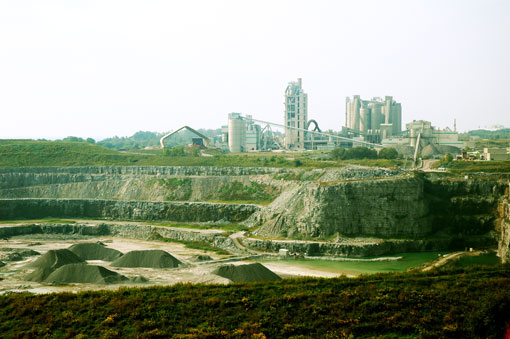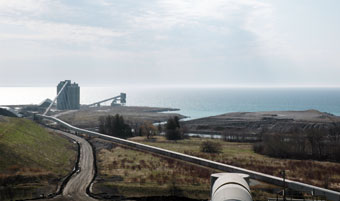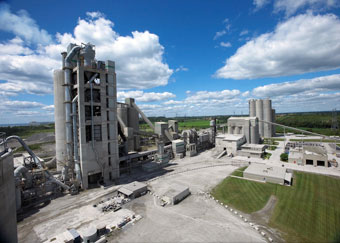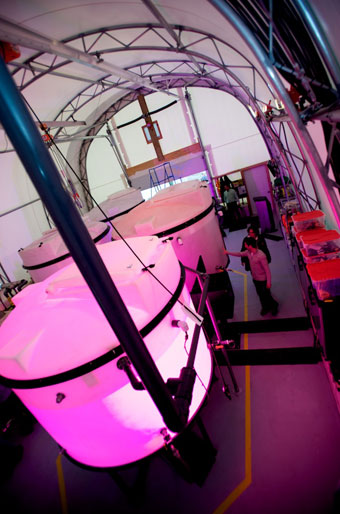Bowmanville welcomes IEEE
This year’s IEEE conference will feature a tour of the largest cement plant in Canada, the St Marys Bowmanville facility in Ontario. Over its history, the works has undergone several modernisation projects to reach its current cement capacity of 1.8Mta. Meanwhile, environmental improvements that incorporate innovative technology make Bowmanville an ideal destination for this year’s site visit.

ICR looks forward to meeting delegates at the 57th IEEE-IAS/PCA Cement Industry Technical Conference
and Exhibition, 26-30 April 2015, Toronto, Canada. Visit us at Booth No 11
The Bowmanville plant in Ontario forms an integral part of St Marys’ (Votorantim Group) strategy of serving the Great Lakes region in both Canada and the United States. The facility began operations in 1968 with a single 1000tpd wet-process kiln. From the early 1970-80s, a second 1000tpd wet-process kiln also operated. In the late 1980s, a new 5000tpd FLSmidth dry-process line with a preheater tower and separate line precalciner was installed. The plant was subsequently upgraded to 5800tpd in 2000 and has continued to operate in this configuration since that time, while both wet process kilns have been retired.
The Bowmanville works has been a substantial employer in the local area since its launch and today employs more than 100 members of staff.
Over its history, the Bowmanville plant has seen many changes to its production process, and its ability to modernise and adapt has been crucial to its long-term survival when several other plants have closed.
As the selected site visit for this year’s IEEE-IAS/PCA Cement Industry Technical Conference, the plant offers delegates the opportunity to witness the latest technology in action on a grand scale. “This is a 1990s kiln that’s been modernised over time,” says Martin Vroegh, local chair and director, environmental affairs at Votorantim North America. “People will be able to see the kind of modernisation that can be made, such as the modern emissions control systems, SNCR, the lime hydrator project, upgraded cooling efficiency and production increases.”

Lake Ontario is a vital link in bringing coal and
gypsum to the plant. The vast majority of cement and
clinker is also transported by ship. Over half of all
production from the Bowmanville plant moves by ship to the USA.
Raw materials
The main raw material constituent of limestone is sourced from the on-site Bowmanville Quarry. The reserves amount to a further 90-100 years of quarrying at current utilisation rates and rock is blasted and fed to a Fuller-Traylor® TC 1500tph gyratory crusher on site to reduce material to a diameter >20cm. Bridge Gap Engineering refurbished this crusher in 2013. A secondary 900tph Pennsylvania hammer mill crusher further processes material to a diameter >10cm.
The quarried rock is transported with Caterpillar and Hitachi 90t dump trucks, and the quarry also operates two Caterpillar loaders and a D8R bulldozer. There are 12 benches at the quarry, each of which has different chemical properties. Therefore two benches are usually worked at the same time to aid material consistency. The plant requires 70,000t of crushed limestone per week. Due to these relatively high levels of activity, maintenance is particularly important and is contracted to Wajax Industries of Toronto.
While the quality of the limestone is very high, the plant adds sand, iron, overburden and ash to improve the raw meal. Furthermore, clay is mined from reserves adjacent and to the east of the quarry. The plant has concrete silo bins for additives storage, which are later fed with the crushed limestone to a 450tph FLSmidth Atox® raw mill, driven by a 450hp motor. During crushing, the raw materials are dried by hot gases from the preheater via two 2000hp fans.
The raw meal is kept in a 42,500t continuous-flow homogenising concrete silo where it is blended via seven extraction withdrawal points from the silo bottom.
Fuel types
The plant’s fuels are imported, and coal and petcoke arrive at the port on the shores of Lake Ontario. While there are raw material stockpiles situated close by, coal is brought directly to the plant to prevent dust emissions.
Petcoke and coal are crushed in a 30tph FLSmidth Tirax coal mill. The plant also keeps diesel oil for preheating. Fuel is fed to the kiln and precalciner from the fuel storage bins by a Schenck fuel delivery system, while the kiln’s main burner is a 15tph FLSmidth Duoflex burner.
Pursuit of alternative fuels usage
While alternative fuels are not utilised at present, Bowmanville has a permit pending to use plastics. A 90-day trial will also be scheduled for this summer (including the use of paper fibres and wood waste) with substitution rates of up to 30 per cent targeted. An additional low-carbon alternative fuel application to burn 100tpd of non-hazardous woody biomass from non-recyclable construction and demolition materials is also being explored.

St Marys 1.8Mta Bowmanville works has
undergone many changes over the years.
Pyroprocessing
A five-stage, two-string preheater is equipped with a bucket elevator to transport raw meal to the cyclones. The precalciner raises temperatures to 840°C. Bowmanville’s 6500tpd three-pier kiln (f5m x 80m) increases the process temperature further to 1000°C. It is driven by a 1250hp main drive and equipped with a 75hp emergency drive. Engineers can also monitor the kiln with the Raytek shell scanner and Flir PM695 ThermaCam. The kiln is lined with Ankral refractory bricks from RHI of Germany.
Clinker enters a modified four-grate Folax horizontal clinker cooler with an IKN fixed inlet to allow a maximum throughput rate of up to 6200tpd. Aumund pan conveyors then transport clinker to the clinker silos or directly to the finish mills.
Meanwhile, the central control unit uses an Invensys Foxboro/PLC process control system to manage the pyroprocessing section of the plant.
Finish grinding process
The plant has the capacity to store 215,000t of clinker. Three FLSmidth ball mills are installed for finish grinding, two of which existed when the plant operated as a wet-process facility, while the third mill was originally a slurry mill for wet-process feed and has since been converted into a cement grinding mill. Overall grinding capacity is 1.8Mta.
A 244tph Koppern roller press is also installed at the plant and is used to pregrind clinker for all cement types before it is further processed by the three ball mills. Gypsum for finish grinding is shipped in via Lake Ontario from Nova Scotia. Cement silo storage capacity is 110,000t.
Emissions control and energy management
A selective non-catalytic reduction (SNCR) system injects ammonia into the clinker kiln exhaust gases to reduce NOx by as much as 40 per cent. The system was installed at the Bowmanville plant following the first successful introduction of the technology at Votorantim’s Suwannee plant in Florida, USA, in 2004.
SO2 emissions were also cut by 56.5 per cent in 2006 when a lime injection system was installed at the plant. The Bowmanville plant now can continuously monitor its emissions. The plant is currently carrying out a lime hydrator project with FLSmidth. The equipment hydrates calcined raw meal extracted from the exit gas stream of the calciner and bottom cyclone to control SO2 emissions.
Plans to capture CO2 at the plant are also underway. Flue gas will be taken at the stack and injected into a series of algae-filled bioreactors, which are stimulated with advanced LED and natural lighting to absorb CO2. St Marys intends to convert the algae into fuel and other high-value products.

Inside the Pond Biofuels building.
The technology, by Toronto-based company Pond Biofuels, is currently being piloted at Votorantim’s plant in St Marys, Ontario, with plans of increasing the project scope at Bowmanville.
In 2011 Bowmanville plant was also the first North American cement facility to be awarded the ISO 50001 certification for its energy management. Improvements saw energy intensity fall by two per cent annually and greenhouse gases were reduced by slightly less than one per cent. Energy operating costs fell by eight per cent, amounting to annual savings of CAD750,000m.
Redecam of Italy further improved Bowmanville’s operating costs in 2012 by removing the obsolete heat exchanger and installing an air-to-air heat exchanger to cool gases from the clinker cooler. A new Redecam DPD-Model bag filter was also installed, along with a new ID fan.
Lab highlights
One of the highlights of the plant tour will be a visit to the on-site laboratory where St Marys Cement has recently added a Perkin Elmer Inductively Coupled Plasma (ICP) Atomic Emission Spectrometer which can create a 10,000°C flame to break down samples into their original chemical elements with measuring accuracies as high as parts per billion. Carbon sulphur analysis is also carried out with a Leco instrument and further equipment from Herzog and Philips (now PANalytical) XRF equipment will be available to see.
To market
All cement from the Bowmanville facility is delivered in bulk. The cement types produced include Portland limestone cement, CEM I, II, III. General Use (GU) cement with high Blaine uses Type I clinker and, together with GU Limestone and High-Early (HE) strength cements, is sold nationally. Type I, II and III cements are also exported to the US markets. Type I and GU cements make up 90 per cent of what is produced at the plant.
Of the 1.7Mt of clinker that will be produced at Bowmanville in 2015, 0.67Mt will be transported via the Great Lakes to the St Mary’s Detroit, Michigan, grinding facility from where cement is dispatched to end markets. A further 0.5Mt of cement is also exported directly to other US markets. The remainder is consumed domestically with road and rail transport available for deliveries. Road trucks deliver to the Greater Toronto area and southeastern Toronto.
| Table 1: main equipment and specifications at St Marys Bowmanville plant |
||
| Equipment | Supplier | Specification |
| Primary crusher (tph) | Fuller-Traylor TC | 1500 |
| Secondary crusher (tph) | Pennsylvanian Crusher | 900 |
| Raw material storage (t) | Live stockpile | 27,200 |
| 21,494 | ||
| Homogenising silo (t) | FLSmidth | 42,500 |
| Raw mill (tph) | FLSmidth Atox |
450 |
| Coal crusher (tph) | FLSmidth Tirax | 30 |
| Preheater/calciner | FLSmidth | 5-stage, 2-string with ILC |
| Kiln with bypass (tpd) | FLSmidth | 5800 |
| Refractiories | RHI | Ankral Z1, R1 and V1 |
| Main burner (tph) | FLSmidth Duoflex | 15 |
| Clinker cooler (tph) | FLSmidth Folax | 5800 |
| Pan conveyors | Aumund | |
| Process control | Invensys | Foxboro/PLC |
| Clinker pregrinding | ||
| Roller press (tph) | Koppern | 244 |
| Finish grinding (tph) | FLSmidth | 3 x 55 |
For more details on this year's IEEE-IAS/PCA Cement Conference, click here. To learn more on some of the key exhibitors at this year's event, view our Conference Preview.

